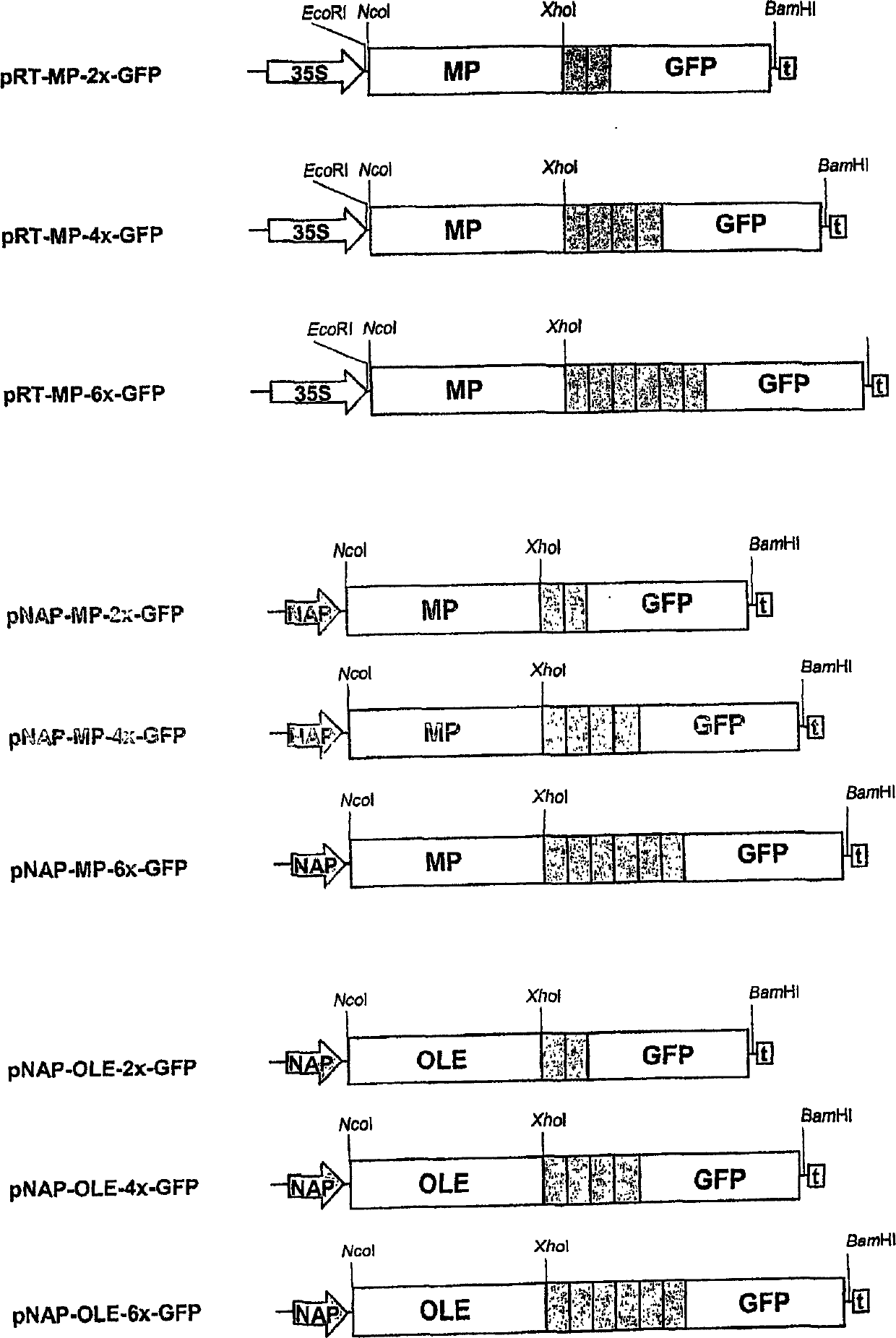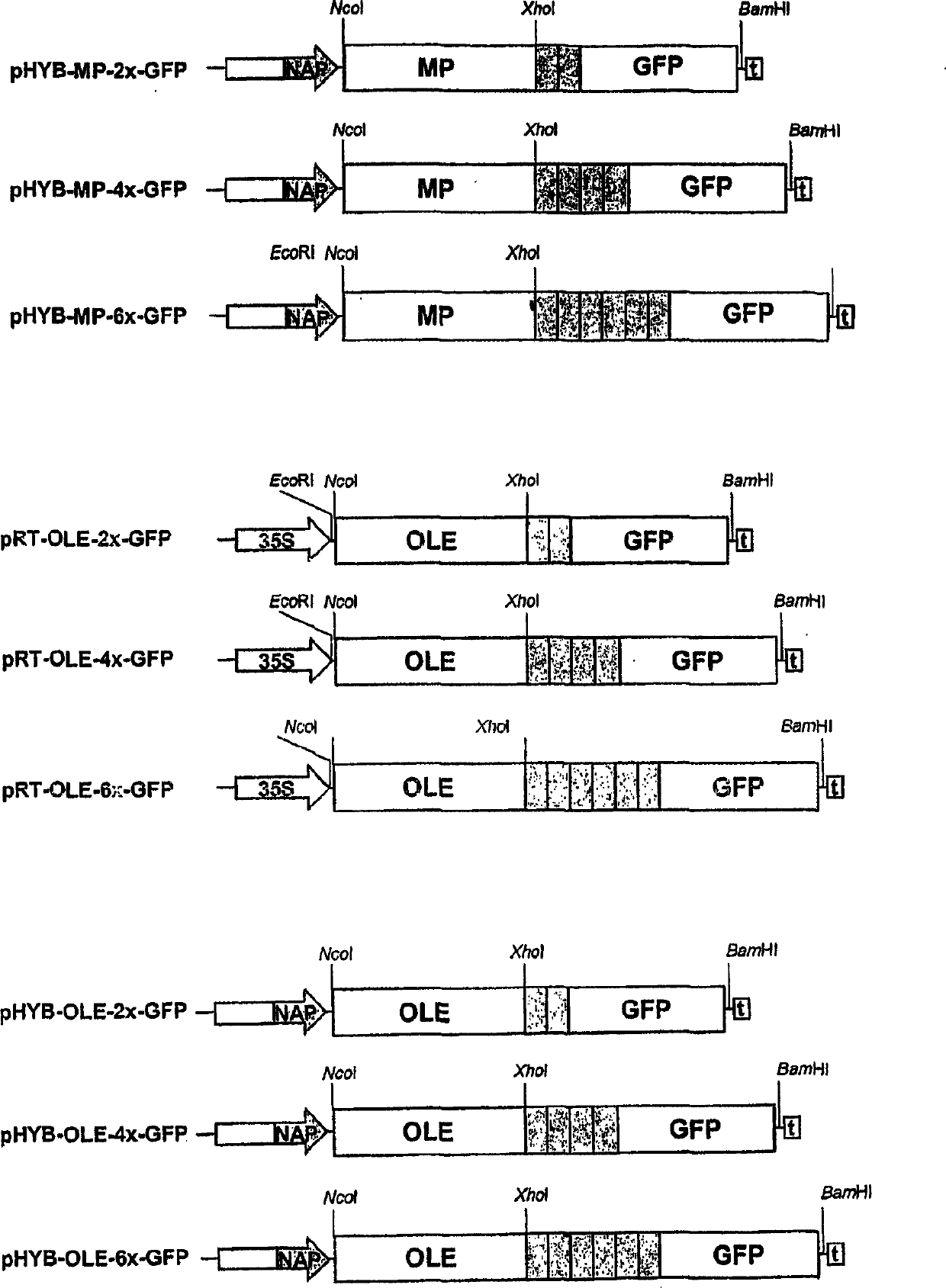Methods and constructs for increasing the content of selected amino acids in seeds
A technology of constructs and amino acids, applied in the field of plant biology, can solve problems such as abnormal seed physiology
- Summary
- Abstract
- Description
- Claims
- Application Information
AI Technical Summary
Problems solved by technology
Method used
Image
Examples
Embodiment 1
[0092] Chromosomal DNA isolation and PCR
[0093] Chromosomal DNA was isolated as follows. Homogenize 300 μg of Arabidopsis leaf tissue into a fine powder in liquid nitrogen with a mortar. Then 3 ml of 100 mM Tris-HCl; pH 8.0, 500 mM NaCl, 50 mM EDTA were added, further triturated after adding 600 μl of 10% SDS and 500 μl of 20% polyvinylpyrrolidone (average molecular weight 360,000). The mixture was transferred to a polypropylene test tube and incubated at 65°C for 10 minutes. Then 450 μl of ice-cold potassium acetate was added to the solution, and the mixture was gently shaken by inverting the tube, incubated on ice for 30 minutes, and centrifuged at 8000 rpm for 10 minutes at 4°C. The supernatant was extracted with phenol / chloroform (1:1), and the DNA was precipitated with isopropanol. Precipitated DNA was washed with 70% ethanol, air-dried, and dissolved in 10 mM Tris-HCl; pH 8.0. The PCR reaction mixture included 1×PCR buffer (10× buffer: 500 mM KCl, 100 mM Tris-HCl; ...
Embodiment 2
[0095] Synthesis and cloning of histidine codon-enriched DNA sequences
[0096] To construct histidine codon-enriched DNA fragments, three chemically synthesized ssDNA fragments were used:
[0097] H-P-1 (SEQ ID NO: 1)
[0098] 5'-GCGCCTCGAGTTCACCATCACCATCATCACCATCACGGGCACCATCAC,
[0099] H-P-2 (SEQ ID NO: 2) 5'-CATCACCATCACCATGG and
[0100] H-M (SEQ ID NO: 3)
[0101] 5'-CCGGATCCTAAAGTCGACCATGGTGATGGTGATGGTGATGGTGCC.
[0102] In order to obtain dsDNA fragments with His codon-enriched sequences, oligonucleotides H-M and H-P-2 were dissolved in 1X AMV reverse transcriptase (RT) reaction buffer (50mM Tris-HCl; pH8.3, 50mM KCl, 10mM MgCl 2 , 0.5 mM spermidine, 10 mM DTT), annealed at room temperature for 30 minutes, and the chain extension reaction was carried out at 37°C for 45 minutes in the presence of 1X AMV RT buffer, 1 mM dNTPs and 1 unit of AMV RT. The reaction products were separated by agarose gel electrophoresis from unannealed oligonucleotides, purified, and inc...
Embodiment 3
[0104] Synthesis and cloning of cysteine and methionine codon-enriched DNA sequences
[0105] For the construction of cysteine and methionine codon-enriched DNA fragments, two chemically synthesized ssDNA fragments were used:
[0106] C-M-P-1 (SEQ ID NO: 4)
[0107] 5′CACCTCGAGTATGTTGTTGCATGTGCATGTGCTGTTGCATGTCGACAAAC 3′
[0108] and C-M-P-2 (SEQ ID NO: 5)
[0109] 5′GTTTGTCGACATGCAACAGCACATGCACATGCAACAACATACTCGAGGTG 3′
[0110] To obtain dsDNA fragments with Cys / Met codon-rich sequences, oligonucleotides C-M-P-1 and C-M-P-2 were incubated in 1X DNA polymerase I large (Klenow) fragment buffer (50 mM Tris-HCl; pH 7.2, 10mM MgSO 4 , 0.1 mM DTT) at room temperature for 30 minutes. A dsDNA fragment of the expected size (50bp) was excised from an agarose gel (after appropriate electrophoretic separation), purified, digested with XhoI and BamHI, and cloned into the similarly digested cloning vector pGEM-7Zf(+)( Promega Corporation, USA; catalog number P2251). After restri...
PUM
 Login to View More
Login to View More Abstract
Description
Claims
Application Information
 Login to View More
Login to View More - R&D
- Intellectual Property
- Life Sciences
- Materials
- Tech Scout
- Unparalleled Data Quality
- Higher Quality Content
- 60% Fewer Hallucinations
Browse by: Latest US Patents, China's latest patents, Technical Efficacy Thesaurus, Application Domain, Technology Topic, Popular Technical Reports.
© 2025 PatSnap. All rights reserved.Legal|Privacy policy|Modern Slavery Act Transparency Statement|Sitemap|About US| Contact US: help@patsnap.com



